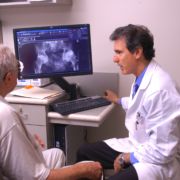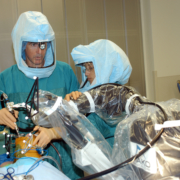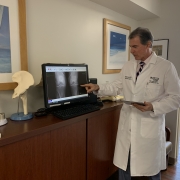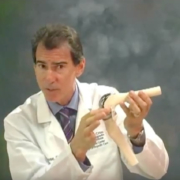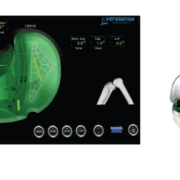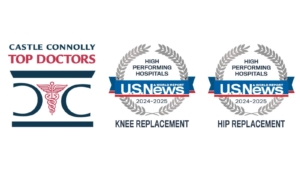Pain and Discomfort after Total Knee Replacement Surgery: Signs TKR Has Failed
Total knee replacement (TKR) has been one of the most successful surgeries developed over the past century and has improved the quality of life for countless people. In fact, it’s in the top three along with total hip replacement and cataract surgery. Today, TKR is the most commonly performed inpatient orthopedic procedure in the U.S. Considering our aging baby boomers and skyrocketing obesity, some consider the demand for TKR an epidemic. In 2030, approximately 3.5 million people will undergo TKR in the U.S.
The goals of TKR are to restore function, minimize pain and enhance quality of life. Multiple studies have demonstrated that one in five people (approximately 20 percent) who undergo TKR remain “unsatisfied” with their results. Many complain of stiffness, loss of range of motion, instability and pain. Patients are playing an increasing role in making their own healthcare spending choices thus patient satisfaction is influencing how care is delivered. Our American healthcare system is entering into an era in which physician and hospital compensation will be tied to patient satisfaction and preventable complications.
It is critically important that we identify why someone is not happy after knee replacement so we can treat them. Fortunately, there is motivation among healthcare providers and those in the healthcare system to decrease the number of individuals who are not satisfied after TKR, as it is very costly when patients don’t do well. Some 55,000 revision TKR surgeries are done each year in America, which costs the system $2.7 billion dollars and projections are that the costs will rise to $13 billion by 2030.
If you had TKR and still having a problem, how do you go about finding out answers to improve your situation? First, you should return to your surgeon for an exam and further work-up. It might be appropriate to seek a second opinion and care from another physician if you feel the problem is not fully being addressed or solved. Figuring out why a total knee hurts can be difficult and not always obvious or conclusive.
Infection after TKR must always be considered and ruled out. If this is not addressed, then whatever else you do will not be successful. Not infrequently, the knee will not look red, feel hot or have drainage but still can be infected. If you are experiencing systemic symptoms such as fever, chills, or myalgia (muscle achiness), these are suspect for infection. Also, if the problem started soon after an infection elsewhere in your body (i.e., a urinary tract infection or upper respiratory infection) or a procedure such as a dental cleaning, infection of the knee also is suspect. TKR infection remains a huge problem and commonly accounts for why someone is not doing well after TKR.
A careful history is important. If a patient comes to me with discomfort and complaints, the first thing I want to know is if he or she ever did well after surgery or if the knee has been painful and the result disappointing from the beginning. I inquire if there were any wound problems after surgery or history of the knee being infected. If an infection is present, frequently patients report discomfort all the time, especially at night. If the knee feels unstable or painful only with activities or movement, it might suggest another etiology. I inquire if he or she has a history of metal allergy or inability to wear costume jewelry. This may suggest a hypersensitivity to one of the metals contained in the prosthetic.
During the interview, I observe my patient. Does he or she appear to be in pain even at rest and/or positioning the knee into flexion for comfort? This would suggest the presence of an effusion, which is excess fluid in the knee that may or may not be pus. An effusion is consistent with an inflamed knee but is not specific. I look at the muscles that control the knee and compare them to the opposite side. Often I’ll see atrophy, particularly with the medial head of the quadriceps, called the vastus medialis obliquus (VMO). I observe the patient’s gait – is it normal or painful? Does it appear unstable? Does he or she spend less time during stance phase of the gait cycle on the operated leg than on the normal leg? Does the alignment of the limb appear normal? All of these are clues. I see many individuals with painful, “unhappy” TKRs who walk without limp.
As I examine the patient’s knee I discern how the incision healed – if it appears pink or red or if there’s an area that’s draining. I look for a rash and check if the knee feels hotter to the touch than the other knee. I evaluate for swelling, the presence of an effusion and if the underlying synovial tissue feels thickened or boggy. I compare the medial (inner) stability of the knee to the lateral (outer) stability throughout the range of motion. Anterior (forward) to posterior (backward) stability is checked as well as the arch of motion. Comparing the prosthetic knee to the other knee often lets me know what is normal or comfortable for that patient, assuming the other is knee asymptomatic.
Rarely, a metal hypersensitivity (metal allergy) can cause painful and persistent synovitis and effusion which mimic an infection. It may present with an eczema-like rash over the outside (lateral) of the knee, although much more extensive rashes have been reported. A metal allergy to the prosthesis is a diagnosis of exclusion with underlying infection being much more probable. At this time, a reliable skin (patch testing) or laboratory test (lymphocyte transformation test) does not exist. Also, no evidence has shown that patients with a known metal allergy have a higher rate of failure or revision of primary TKR than those without a positive history. If a decision is made to revise the TKR, it should be made with great caution and appropriate and guarded patient counseling.
The patient’s work-up should include a CRP and ESR, which are sensitive blood studies that measure inflammation. If these studies are elevated or index of suspicion for infection is high due to the history or physical exam, then the knee should be aspirated. A needle is inserted into the knee and fluid removed for study. The fluid then is examined to determine the number and percent of different types of white blood cells present. The fluid also is cultured and analyzed for crystals. I also send this aspirated fluid for a recently developed study called a Synovasure test, which checks for the biomarker alpha defensin. It has shown to be 97 percent sensitive and 96 percent specific for infection and, in my opinion, has been a testing “game changer.”
A crystalline arthropathy, when crystals accumulate in the knee, also can cause symptoms that mimic an infection. A history of gout or pseudogout is more suspicious, so studying the aspirated fluid for crystals is appropriate. Occasionally a crystalopathy and infection both are present.
If the work-up does not demonstrate an infection then other causes for implant failure must be considered. These include implant loosening, improper soft tissue balance, malalignment and wear. A history of trauma resulting in fracture or soft tissue disruption can lead to failure. An implant extending past normal boney contours occasionally can lead to soft tissue irritation, impingement and a less-then-satisfactory result.
As the knee flexes, imagine the lateral (outside) femoral condyle rolling off the back of the lateral tibial plateau, which results in the tibia internally rotating. As we extend our knee, the tibia externally rotates and the lateral femoral condyle resumes its position on the tibia. The boney and soft tissue structures of the knee have developed to accommodate and control for this normal, complex “screw home” movement and the surrounding soft tissues guide this motion.
When replacing a knee, the closer the prosthetic knee achieves this complex kinematic movement the better and more comfortable it will be. This requires cutting the bones so alignment is restored, optimizing placement of the femoral and tibial components relative to each other to achieve “congruency” and create central patella tracking. Additionally, the soft tissues must be “balanced” to guide this complex movement with loads or tensions on the ligaments medially (inside) and laterally (outside) adjusted to be within an optimal physiologic range (not “too tight” or “too loose”) and within 15 pounds of each other throughout the range of motion.
In a recent blog article I described how I accomplish this by using the Verasense Knee System. It’s a tall order and helps explain why mal-rotation, malalignment and soft-tissue imbalance account for 40 percent of premature implant failures, especially considering that until recently surgeons haven’t had the technology to quantitate inter-compartmental differences and measure knee kinematics intra-operatively, but rather had to depend on “feel-based” decision making and experience.
Implant loosening also can cause knee pain, swelling and instability. A component may loosen after many years or very soon after surgery. An X-ray can determine this by showing the separation between the prosthetic and either bone cement or bone, or subsidence of the component. X-rays also can show bone destruction called osteolysis – friction caused by the prosthetic joint surfaces moving against each other that results in the release of small particles of plastic which incite an inflammatory response and activate cells that destroy bone. The released particles also might cause a “polyethylene synovitis” which can result in pain, swelling, instability and stiffness.
An X-ray can show bone destruction which also could be from infection or fracture. If the bone that supports the prosthesis is fractured, loosening and instability may result. Sometimes special X-rays (using a fluoroscope or cat scan) must be taken to see more clearly the interfaces between the prosthesis and bone in order to make a diagnosis of loosening. Occasionally, a bone scan also is indicated.
Most but not all modern-day TKR systems have very good track records for performance and longevity so, if other more common causes for a painful TKR are not present, it is appropriate to know the track record of your particular implant.
In my next blog article, I’ll discuss how I treat and correct a specific problem and unsatisfactory post-operative TKR result. I’ll also discuss how I use the Verasense Knee System intra-operatively to help me diagnose malalignment, improper soft tissue balance and instability, and then guide my correction.
We thank you for your readership. If you would like a personal consultation, please contact our office at 954-489-4575 or by email at LeoneCenter@Holy-cross.com.

